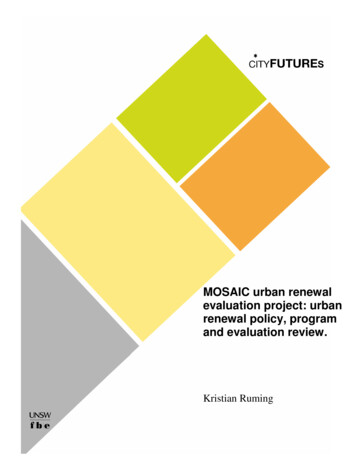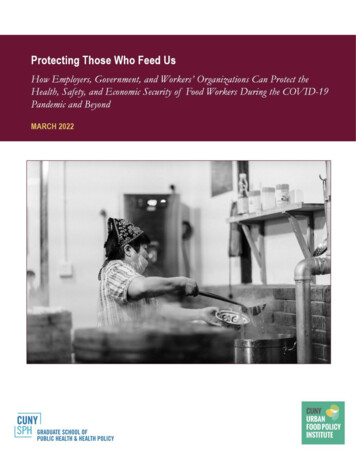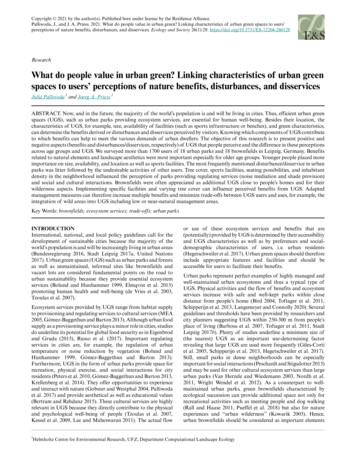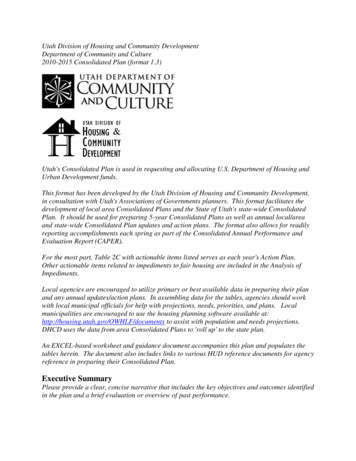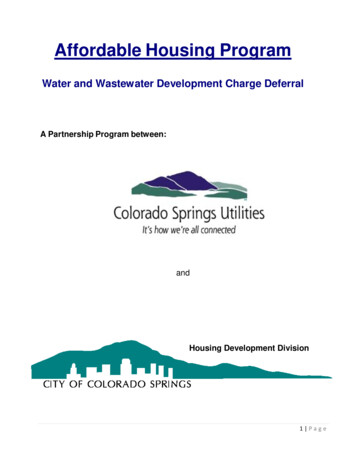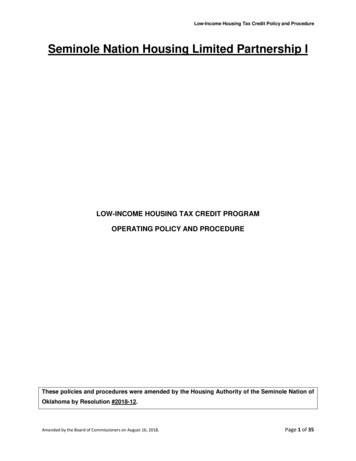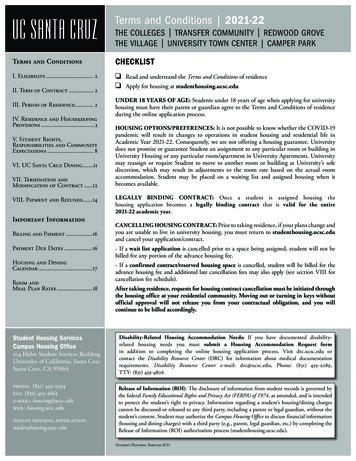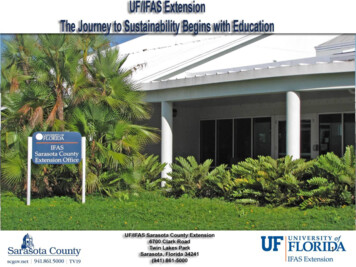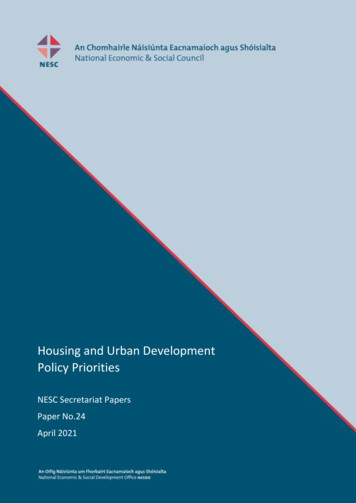
Transcription
1Housing and Urban DevelopmentPolicy PrioritiesNESC Secretariat PapersPaper No.24April 2021
2Housing and Urban DevelopmentPolicy PrioritiesDr Cathal FitzGerald,Mr Noel CahillDr Damian ThomasNESC Secretariat PapersPaper No.24April 2021The NESC Secretariat Papers provide analysis of economic, social or environmentalevidence and policy. The views are those of the authors and do not represent thecollective view of the Council.A list of the full set of NESC publications is available at www.nesc.ie
iTable of ContentsIntroductioniChapter 1: Policy Options81.1Robust Developmental Institutions91.2Making Sure Development Happens151.3Engineering Affordability Into Supply241.4Adequate, Targeted Financial Mechanisms401.5Embedding System Change461.6National Programme of Flagship Projects481.7Construction Sector Capacity and Productivity50Chapter 2: Discussion: Prioritisation, Targets and Implementation53Appendix 1:The Social Housing Approval Process58Appendix 2:An Affordable Rental Scheme: Between theState and Market59Bibliography60List of FiguresFigure 1: Impact of the Dominant Business Model on theHousing Market4Figure 2: NESC Secretariat’s System-Wide Approach toIncreasing Affordable Supply6List of BoxesBox 1:Adoption and Use of Site Value Taxes21Box 2:Cost Rents & Local Authority Rents in Ireland28Box 3:Classification of Organisations in the General Government Sector45
iiAcknowledgementsThe authors wish to thank colleagues at the following organisations for their inputto this research: Department of Public Expenditure and Reform, Department ofHousing, Local Government and Heritage, Department of the Taoiseach, Office ofthe Planning Regulator, Land Development Agency, Housing Supply CoordinationTask Force for Dublin, Housing Finance Agency, Home Building Finance Ireland,Ireland Strategic Investment Fund, and Office of Government Procurement. Theauthors alone are responsible for the content of this report.
iIntroduction
2In June 2020, the National Economic and Social Council (NESC) Secretariat1 wasasked by the Department of Public Expenditure and Reform (DPER) to undertakeresearch to address the following question:What are the policy options available to facilitate the delivery of publicand private housing in line with the compact growth targets set out inthe National Planning Framework (NPF) and related policies in a newProgramme for Government?2The research presented in this Secretariat paper, carried out over six weeks,involved: summarising relevant material from NESC’s extensive body of related research; collating material from external sources, including the Department of PublicExpenditure and Reform (DEPR), Department of Housing, Local Government andHeritage , Office of the Planning Regulator (OPR), Land Development Agency(LDA), Housing Supply Coordination Task Force for Dublin, Housing FinanceAgency, Home Building Finance Ireland (HBFI), Ireland Strategic InvestmentFund (ISIF), Office of Government Procurement (OGP), and relevant others; and synthesising and analysing the above to identify and prioritise high-impact policyoptions.The NESC Council’s system-wide view of housing policy informs the approach takenin the research reported here. This work was undertaken in the context of the new1The request was to the NESC Secretariat to prepare this analysis. By contrast, NESC reports present the agreedviews of the Council. This report does not necessarily represent the views of the Council or the variousorganisations within it. In this respect, this study differs from a normal NESC report, which presentsgovernment with a collective view developed through shared analysis and deliberation. Some of the material inthis report was used in a report on housing by the NESC Council, Housing Policy: Actions to Deliver Change(NESC, 2020).2‘Compact Growth’ is included in the NPF as one of 10 National Strategic Outcomes. It involves targeting agreater proportion (40 per cent) of future housing development to be within and close to the existing‘footprint’ of built-up areas. Further, it involves making better use of under-used land and buildings, including‘infill’, ‘brownfield’ and publicly owned sites, and vacant and under-occupied buildings, and—in line withNESC’s work on transport-orientated development—higher housing and jobs densities, better serviced byexisting facilities and public transport. Achieving these outcomes will be dependent on a significantacceleration of development in Ireland’s regional cities.
3Programme for Government and proposed review of the National DevelopmentPlan (NDP). The work is not intended to provide a comprehensive assessment of thechallenges and solutions, but rather to suggest high-impact and deliverable optionsbased on previous work and the most up-to-date guidance from and withingovernment departments, bodies and other experts.The Council has a long record of analysis in the area of land use, housing, the privaterental sector, and urban development policy. For example, it is 16 years since theCouncil outlined the key role of land supply and land cost in housing andinfrastructure (NESC, 2004). More recently, NESC produced research reports on costrental as an effective and fiscally sustainable model (NESC, 2014a); on the centralconsiderations for homeownership and rental (NESC, 2014b); on policy action toensure affordable rents (NESC, 2015b) as well as research on more desirable andsustainable forms of urban development (NESC, 2019). Perhaps the most significantpiece of work in this area was the Council report Housing and Infrastructure: FixingIreland’s Broken Housing System (NESC, 2018), which was prepared after theRebuilding Ireland strategy had been in place for some time.That report’s central message is that Ireland must change its system of urbandevelopment, land management and housing provision—that the system isdysfunctional and that a suite of actions were and are required to fix it. It points tokey aspects of the problem, which inform the options set out in later sections of thisreport—i.e. the dominant business model applied in the housing sector, theresulting land-price trap, with development normally being close to the margin ofviability, and competition occurring at the ‘wrong’ stage in the housing market(NESC, 2018a).To summarise, the uncertainty and variability of land supply increases theuncertainty and risk that developers face, on the one hand; on the other, it givesgreat market power to particular owners of urban development land. If developersand builders are to maintain continuity in their operations, they need to ensure thatthey have an ongoing supply of suitably located sites. They cannot rely on themarket making land available at the time they require it. To ensure adequate land,developers need to invest in land banks. The practice of land-banking bydevelopers, in turn, becomes another influence on the supply of land in the market.Because the land available for development is limited, developers compete withone another for a scarce supply of sites. This tends to create rising land prices, and itencourages developers to buy and hold land.The price developers are willing to pay for development land depends on the pricethey expect to be able to charge for homes, less the projected costs of producingthe homes and a profit margin. A report published by KPMG and Shelter hasdescribed the resulting ‘land price trap’ as follows:Whoever bids most optimistically—either betting on higher houseprices or lower build costs will win the site. This ratchets up the targetprice at which builders must sell homes to make their profit margins,
4forces down the quality and size of new build homes, and putsdownward pressure on affordable housing obligations (Jefferys et al.,2014: 38).The effect of the dominant business model and the resulting land-price trap, withdevelopment normally being close to the margin of viability, is competitionoccurring at the ‘wrong’ stage, in the volatile land market rather than in the housingmarket.Figure 1: Impact of the Dominant Business Model on the Housing MarketSource: Jefferys et al., (2014).From the outset, it is thus crucial to recognise that the housing system is just that:an interrelated system, where change is complex and takes time. The Council hasstated that, without a change in the system, we are condemned to an endlesssequence of isolated measures that seek to generate a little more viability, a slightreduction in risk, a marginal increase in supply, a slightly higher share of affordablehousing and a minor shift from greenfield to brownfield development. Ireland hasbeen taking such isolated measures for long enough to learn that they are not
5working. It is axiomatic that viability is directly relevant to output and affordability.This provides the context for the policy options outlined below.As the Council noted in 2015, the approach frequently involves one aspect—be itthe planning process, standards, costs, finance or land hoarding—being describedas the problem, and one marginal action being advanced as the solution (NESC,2015a). Indeed, sometimes one policy initiative cancels out the effect of others.Taking a system-wide approach can also be seen as resulting in ‘too manyrecommendations’, meaning that the impact of potentially significant measures thatcould influence system change is at risk of being diluted. In all cases, deeperconsideration of options will be required by the responsible governmentdepartments in a collective forum. Besides not working, the focus on a succession ofdiscrete issues both creates and reinforces the game of ‘pass the parcel’, in whichblame is passed between government, local authorities, landholders, developers,builders, and even the homeless. As one expert makes clear, it is illogical to blamevarious actors for exercising what power they have, ‘rather than examining theworkings of the system which gives them this power’ (Evans, 2004: 175).Flowing from above, this report suggests a co-ordinative, action-orientatedapproach rather than isolated actions. The Secretariat believes that such a systemwide approach can address the two gaps highlighted in the request made to it—thesupply gap and the affordability gap—in a tangible way, by ensuring developmenthappens and by engineering affordability into that development.In setting out priority options, the starting point is recognition that direct publicpolicy influence is needed on housing supply and urban development, particularlyto put land in the hands of actors who will develop it (see Figure 2). Thisnecessitates the establishment or presence of public institutions with a strongdevelopmental mandate, political authorisation, and executive capacity. To ensuredevelopment happens, these institutions must operate ‘in the shadow’ of a crediblesystem of compulsory purchase of urban development land.To ensure that development delivers affordable housing, affordability must beengineered into policies to increase the supply of housing. This suggests, forexample, a requirement for affordable housing on private land beyond current PartV, a higher level of social and affordable housing on public land, and a commitmentto a national cost-rental strategy at scale. Further, absent a construction sector withthe capability and capacity to deliver the required supply, these interventions willcount for little. Finally, to reveal the knots which must be unknotted and todemonstrate the commitment and ability of the State to deliver on its objectives, anational development programme should name strategic sites to provide affordablehousing at scale.
6Figure 2: NESC Secretariat’s System-Wide Approach to Increasing AffordableSupply
7Adopting this overall approach, the Secretariat’s research and policy options are setout as follows: Section 1.1: Robust Developmental Institutions Section 1.2: Making Sure Development Happens Section 1.3: Engineering Affordability Into Supply Section 1.4: Adequate, Targeted Financial Mechanisms Section 1.5: Embedding System Change Section 1.6: National Programme of Flagship Projects Section 1.7: Construction Sector Capacity and ProductivityChapter 2 deals briefly with issues not featured in the original request, but ratherarose during the consultation process and which the Secretariat was asked todiscuss: prioritisation, targets and implementation. Additional material can befound in the Appendices.
8Chapter 1:Policy Options
91.1Robust Developmental InstitutionsIn its 2018 report, the Council argued that achieving the ambitious goals of ProjectIreland 2040 would require a fundamentally new approach to relationshipsbetween housing, transport, and urban development. In particular, there is a needfor public institutions with a strong developmental mandate that have the politicalauthorisation and executive capacity to take action and drive sustainable urbandevelopment, including the increased provision of affordable housing.This recommendation reflected the view that effective land management andsustainable urban development requires authoritative public institutions with thecapacity to work collaboratively with relevant public agencies and private and notfor-profit development and housing organisations. In the absence of suchauthoritative public actors, there will remain a gap between knowledge, plans andinsights on the one hand, and, on the other, the authority and capacity to takeaction that can make a real difference to housing, transport, and urbandevelopment.Achieving tangible progress with regard to housing and active land management willrequire creative thinking, a multidimensional approach and intensive and ongoingcollaborative action between public and private-sector actors. In his study ofsuccessful urban developments in European countries, Hall emphasised the centralrole of authoritative public agencies taking the lead in this process:3Whether the precise agent is the city planning department (as inStockholm or Freiburg) or a dedicated public agency (as in Hamburg,Leipzig or the Dutch VINEX developments), the key to success is a wellstaffed and well-led planning office with a dedication to the task andthe professional competence to draw up master plans and engage incomplex arrangements for implementation with the private sector andwith community groups. In every successful case, the detailed casestudies show that from the start the public agency took the lead: it3In its 2015 report, Housing Supply and Land: Driving Public Action for the Common Good, the Councilrecommended that the public system use its authority, capacities and resources to take the lead in theresumption of housing supply (NESC, 2015a).
10drew up a master plan, usually in considerable detail as to the layout ofstreets and buildings and open spaces—even down to the detailedheight and massing of individual blocks—before inviting private orcommunal agencies to make their proposals for detailed developmentof individual elements (Hall, 2014: 305).While this process is led by a public agency, it involves deep and ongoingengagement with both private actors and communities. This collaboration mayinvolve a wide range of contractual, joint-venture, partnership models and financingarrangements. NESC believes that the most critical resource available to the State island in public ownership. A substantial amount of state-owned land exists in ourcities and towns, including large city-centre areas that were former docks or raildepots, other areas in key locations and along new public transport corridorsopened up by infrastructure projects or new dedicated bus routes (Government ofIreland, 2018). The Council believes it is vital that the land be put in the hands ofactors who will develop it in a timely and appropriate manner, rather than seekingto maximise state revenue by selling it outright. It pointed out that this ‘wouldconstitute a change from the approach adopted by many public bodies (NESC, 2018:x).Drawing on this analysis, the Council strongly endorsed the Government’scommitment in the National Planning Framework to establish a new agency thatwould co-ordinate and secure the best use of public lands to drive urbanregeneration, the renewal of strategic areas, and compact and sustainable growth.The Council stipulated that such a public body should promote urban development,through master planning and other measures. Additionally, it should embedpermanently affordable housing into its strategic objectives and actions. TheCouncil moreover identified the key characteristics that are likely to make for aneffective urban development agency: a clearly defined mandate to supply serviced land for permanent affordablehousing and public services such as schools; an adequate level of capital and ability to raise finance; co-ordination with other institutions providing infrastructure, particularlytransport infrastructure; a sufficient number of highly skilled staff with both public-sector and privatemarket expertise; operational independence and autonomy—including the capacity to establishnew development institutions in particular areas—along with effectivearrangements for accountability;
11 the ability to partner with and advise public bodies to use their power andresources to establish new development institutions to drive development inspecific locations (see, for example, Limerick 2030); that it starts by leveraging land in public ownership, and, over time, continues itswork by acquiring private land where possible; and that it works closely with place-based development institutions to deliver majorprojects.The decision in the Programme for Government to establish the Land DevelopmentAgency (LDA) on a permanent statutory basis as soon as possible is an importantpolicy decision as it provides an opportunity to formally establish a public institutionwith the mandate, expertise and resources to take, in collaboration with otherpublic and private actors, a lead role in driving sustainable urban development andthe increased provision of affordable housing. While highlighting the importance ofworking in a collaborative manner with government departments, local authorities,state agencies and other relevant stakeholders, the Programme for Governmentaffirms that the LDA will have a pivotal and ongoing role in active land managementand housing provision. In particular, it stipulates that: The development of sustainable communities will be the core objective of theLDA, delivering sustainable, climate resilient, low-carbon housing. The LDA will be tasked with driving strategic land assembly to ensure thesustainable development of new and regenerated communities well served byessential services. The LDA will provide homes for affordable purchase, cost rental and socialhousing. The LDA will be mandated to work with local authorities, state agencies andother stakeholders to develop masterplans for strategic sites.Realising these ambitious but achievable goals will require that this statutory bodybe afforded the authority, resources and policy tools to enable it to take effectiveaction and drive sustainable urban development and the increased provision ofaffordable housing, and support compact growth in accordance with the objectivesof Project Ireland 2040. Since access to land is one of the constraints on thedevelopment of new social housing, particularly for Approved Housing Bodies(AHBs), providing land for social housing should be a significant part of its remit.Indeed, while it will be important for the LDA to deliver short and medium-termpolicy outcomes, it is also necessary to recognise its potential to contribute tolonger-term systemic change in the housing and land markets.
12Since its establishment on an interim basis in 2018, the LDA has focused on buildingits organisational capabilities and competencies, and on developing strategic plansfor a number of the sites allocated to it. Recruiting highly qualified staff withconsiderable knowledge and expertise in development finance, urban development,planning and land management has been an integral part of this capacity-building. Ithas also sought to develop productive and co-operative relationships with localauthorities, state agencies, government departments, development bodies andprivate developers. For example, the LDA is currently working with Limerick City andCounty Council, CIÉ and the HSE to develop a mixed-use city-centre neighbourhoodon a 50ha site adjacent to Limerick Train Station.This initiative highlights the LDA’s focus on building sustainable communities basedon a model of transport-orientated development (NESC, 2019), and it is progressinga similar initiative in Galway city centre. It currently has land for 3-4,000 homes.The LDA’s resources, assets, in-house expertise and the actions it has taken to datecertainly suggest that this institution has the potential to effectively undertake thechallenging task of delivering housing at significant scale on public land. It isimperative therefore that the legislation to establish the LDA on a permanentstatutory basis be enacted as quickly as possible. Equally, it essential that theagency be afforded the appropriate policy instruments to enable it to deliver itsambitious mandate. As noted above, the LDA is to play a lead role in strategic landassembly and development, in conjunction with other stakeholders of masterplansfor strategic sites in urban areas. As part of this process, the LDA will undertake acomprehensive audit of state lands, identifying land banks in public ownership thatare suitable for housing and other purposes. Importantly, the Programme forGovernment also indicates that compulsory purchase powers are to be afforded tothe LDA to enhance its capacity for land assembly. As discussed below, a crediblesystem of compulsory purchase for urban development land is one of therequirements to make sustainable urban development happen. It is also an integralcharacteristic of robust and authoritative public development institutions in someother EU states. This reaffirms the importance of reforming the CPO system fordesignated development sites.The Programme for Government indicates that any state lands being offered forsale, whether owned by a local authority, government department, commercial ornon-commercial semi-state agency or any other agency, would automatically firstbe offered to the LDA. The acquisition of land by the LDA at no or low cost isdesirable, and will be the preferred approach where possible given that it wouldmake an important contribution to securing the goal of affordable housing.However, it should be recognised that there is a cost to the Exchequer as thesepublic lands have value for their owners. In some cases, land-sale revenues are usedto help finance public capital projects, as in the case of the Technological UniversityDublin (TUD), Grangegorman.
13While Strategic Development Zones (SDZs) are not solely focused on housing, thestatus of the LDA as the national development agency would be bolstered by astrong, direct role in development in SDZs. This policy initiative is discussed furtherin Section 1.6. There is also a commitment to using modern methods ofconstruction to support the speedier provision of high-quality sustainable homes atscale.Finally, the LDA sits alongside local authorities as key players in the supply ofaffordable housing. Local authorities undertake a vast array of functions to facilitatedevelopment, with the associated complex tasks falling on relatively small teams ofofficials in each local authority. The complexity of the tasks necessitates expertiseand time, while familiarity with the problems and regular use of solutions enhancesthe likelihood of successful outcomes. Access to expertise has a role to play insupporting housing provision and urban development. The process and thedevelopment industry are complex, and highly context-specific, making a high levelof expertise and direct engagement with the industry essential. Local authoritiesmay benefit from expert specialist advice to provide both social and affordablehousing effectively and efficiently to replace skills and experience that have beenlost (e.g. on the establishment of Irish Water).The National Building Agency (NBA) played such a role previously in relation tosocial housing, having the staff and resources, and skills in key areas such asquantity-surveying, engineering, utilities, architecture, and knowledge of thebuilding industry. However, the NBA was involved in a lot of Ireland’s problematicestates, according to the Housing Agency chief executive, as reported by Kelly(2019), and it is important not to repeat its mistakes. At present, the HousingAgency supports local authorities through project feasibility assessments anddevelopment of outline project delivery plans; advisory services on Part V delivery,turnkey delivery, and design and build tenders; undertaking financial assessments ofPayment and Availability Agreement and Capital Advance Leasing Facility (CALF)applications; and contracts preparation and support. Nevertheless, there areadditional critical tasks that local authorities need to undertake, albeit infrequently,to position them as truly robust developmental institutions capable of playing thefullest role in the delivery of affordable public and private housing in line with thecompact growth targets set out in the NPF. This suggests that local authorities, inseeking to undertake necessary, complex tasks around procurement, siteunblocking, CPO, master-planning, etc., would benefit considerably from being ableto leverage the knowledge and expertise of national specialist development teams.In addition, complex and time-consuming local authority planning and developmentfunctions are carried out in the context of low application fees; fees which have notbeen reviewed for almost twenty years.Achieving the LDA’s goals in relation to strategic land assembly and housingprovision will require considerable investment by the State, and it is accepted thatthe activities of the LDA will be on-balance sheet. Given the demands in other areasof public policy, this ongoing commitment in terms of state expenditure will clearlyhave to be factored into future policy dialogue. At the same time, the financial
14expertise in the LDA and other public bodies suggests there is scope to explore howExchequer funding can be blended with other, alternative sources of finance topotentially expand the pool of capital available for investment in urbandevelopment and housing.Secretariat’s suggested priority options Establish LDA on a statutory footing as a matter of urgency, with two primaryobjectives:osustainable urban development and provision of affordable housing;osustainable and sufficient supply of affordable land, including land for socialhousing, for near and longer term. Equip the LDA with a planning role and tools to assemble land and engage in directdevelopment (including CPO, master-planning, and land-value capture). Resolve issues around ‘book value’ transfer of public lands to LDA. Make the LDA the lead development agency for all SDZs, learning lessons fromexperiences of the Dublin Docklands Development Agency and the GrangegormanDevelopment Agency. Ensure the LDA contributes to capacity-building in the construction sector (see Section1.7). Fund local authority planning and development functions adequately and ensuredevelopment application fees reflect the economic cost to the authority. Establish national specialist teams available to local authorities to undertakenecessary, complex tasks around procurement, site-unblocking, CPO, masterplanning, etc. Consider if the LDA is optimal location for these teams.Explore the potential to develop blended funding and financing structures as amechanism for leveraging additional investment in sustainable urban developmentand housing provision
151.2Making Sure Development HappensCredible system of compulsory purchase of urban development landThe Council has stated that, while planning of the kind found in Ireland and Britaincan prevent undesired development, it lacks the ability to ensure that developmenttakes place. Land can be zoned for housing, and even serviced, but there is noguarantee that it will be used within a reasonable period. Indeed, the supplyconditions of land help to create the speculative development land and housingmarket. The focal point for competition is land acquisition and land hoarding, ratherthan quality or value for consumers.NESC has noted that incentivising productive engagement between the public andprivate actors depends on framework conditions, in particular the status of theurban development bodies, their planning powers and a credible system ofcompulsory purchase of urban development land at below full development value,used as a last resort and under judicial supervision.4Even if rarely used, an effective system of compulsory purchase of land can be animportant backup to ensure that land is developed in a timely way in accordancewith local plans. The 1973 Kenny Report advocated a system of active landmanagement linked to measures to capture the land-value uplift or betterment as ameans of capping land prices (NESC, 2004). The Kenny Report proposed that localauthorities would have the right to acquire land at existing use value plus 25 percent in the following circumstances: (i) the land would probably be used during thefollowing ten years for housing, industrial or other development, and (ii) the landeither had been or would be increased in market price by works carried out by localauthorities.A core principle of the Kenny Report regarding the capture of the bettermentremains as relevant today as it was fifty years ago. The State should update the CPOprocess and implement a mechanism to capture betterment in order to control landcosts and ensure affordable housing for future generations. These enhanced policyinstruments would also have the
More recently, NESC produced research reports on cost rental as an effective and fiscally sustainable model (NESC, 2014a); on the central considerations for homeownership and rental (NESC, 2014b); on policy action to ensure affordable rents (NESC, 2015b) as well as research on more desirable and sustainable forms of urban development (NESC, 2019).

